We have lift-off! Dubai gets ready for flying taxis
A new LBS case study by Aharon Cohen Mohliver traces the development of eVTOL technology and its promise in combatting carbon emissions and pollution.

In 30 seconds
Despite despite boasting 12-lane highways, Dubai’s roads suffer from bad traffic congestion and air and noise pollution, causing problems for commuters, tourists and urban planners.
Focus on zero-emission vehicles includes plans to launch “flying taxis” – emission-free electric vehicle take-off and landing craft – by 2026.
New LBS case study traces development of the eVTOL industry and potential of the technology to combat CO2 emissions and air and noise pollution.
Myths come about in cultures for many reasons; not least because they enchant us with tantalising visions of worlds and capabilities beyond the reach of mere mortals. One of the most enduring myths in European culture, dating back to classical Greece, is the story of Icarus, the man who achieved self-powered flight with wings made of feathers and wax. But Icarus flew too close to the sun, which melted the wax in his wings, and plunged to his death. To this day the story remains a byword for man’s hubris.
Our species’ seeming ability to achieve almost anything it can imagine is just one reason why, as soon as I saw – in person – the demonstration of a “flying taxi” cockpit at the World Government Summit in Dubai in 2022, I knew it would make a great LBS case study. Besides the inherently intriguing and photogenic subject matter, it has been fascinating to see the nascent urban air mobility (UAM) industry evolve. (Be warned: like many new technologies, this is a field riddled with acronyms!)
For those who haven’t been there, Dubai may seem an unlikely setting to launch an air taxi service. But although it has a population of only 3.6 million people, its population density of 762.6 people per sq km – an increase of more than tenfold since in 1980 – makes it the most densely populated area in the United Arab Emirates (UAE). And, despite boasting 12-lane highways, its roads have become synonymous with terrible traffic congestion and attendant air and noise pollution, causing headaches for the emirate’s commuters, tourists and urban planners alike.
Dubai’s plan for zero emissions by 2050
That’s why last May the Dubai Road Transport Authority (Dubai RTA) released an ambitious plan to transition to zero-emission operations by 2050, with a focus on zero-emission vehicles, mitigating climate change and minimising carbon footprint.
A key plank in the strategy is the introduction of air taxis, and in February 2024 Dubai awarded a contract to US-based Joby Aviation to launch a service by early 2026, promising “fast, safe, and convenient travel to key city spots”.
The agreement covers various support measures from the RTA, including the exclusive right for Joby to operate air taxis in Dubai for six years, a regulatory approach for early operations, and support for entry and maturing of service. Joby also signed an agreement with Skyports, who will build and operate four “vertiports” in Dubai. (These are dedicated electronic vertical take-off and landing (eVTOL) airports).
Joby’s eVTOL aircraft (below) is designed to carry a pilot and four passengers at speeds of up to 200 miles per hour, with a journey from Dubai International Airport to Palm Jumeirah expected to take just 10 minutes, compared with 45 minutes by car. Dubai RTA estimated it would cost at least 350 dirhams (about £75) per person for a ride in the aerial taxis.

Joby’s electric air taxi on display at the World Governments Summit in Dubai in February 2024. Source: Joby Aviation
Besides reducing road-traffic congestion, air pollution and carbon emissions, analysts predict that eVTOL aircraft could eventually replace helicopters, significantly reduce intra- and inter-city travel time, and become a huge tourist attraction.
Development of the eVTOL industry
The concept of “flying cars” (to alleviate or bypass road traffic) predates eVTOL technologies by many decades. In the 1950s, for example, America’s love affair with all things futuristic gave birth to such visons as Frank Tinsley’s “flying saucer for everybody” (below); which, by rising vertically and flying conventionally, had the potential to “make any backyard an airport.”

The “Flying Saucer For Private Owners”. Source: Mechanix Illustrated.
And, on the occasion of the first annual ‘Sight’ lecture of the Wings Club at the Biltmore Hotel in Los Angeles in November 1964, legendary aviation pioneer Igor Sikorsky discussed the emergence of a new type of airplane then under development: the vertical take-off and landing (VTOL) aircraft.
Sikorsky rightly predicted that, as the likelihood of airports being situated further away from cities increased with urban development, the need for city-to-airport communications would also grow. But, he cautioned, there were “fundamental factors” in VTOL designs that could not be overcome; hence a “proper type helicopter of adequate size” would best suit this purpose. The problem with helicopters, of course, is that they are very noisy and extremely heavy – and not suited to flights or landings in densely populated urban areas. They are also completely unfit for combatting carbon emissions.
Demand for new modes of transportation
In the second decade of the new millennium, societies started embracing the urgency to combat climate change. Allied with the growing global demand for efficient and sustainable mobility in metropolitan areas, this inspired innovative approaches to new modes of transportation and new vehicles. Rapid advances in electric vehicle transportation systems – including electric motors and non-fossil-fuel energy-storage systems (such as battery-electric, hybrid-electric and hydrogen-electric systems) – motivated the exploration of new opportunities for on-demand urban air mobility; often assisted by supportive government policies and public sector R&D in Europe, North America and China.
“Companies eyed a frenzied public market driven by retail investors in search of the Tesla of the sky”
The eVTOL industry grew massively from around 2017 and has not stopped since. The lack of approved designs – not to mention the far-off possibility of achieving certification – did nothing to deter existing players and new market entrants from seeking massive capital injections for the R&D needed to reach certification and market launch. They found the VC industry a receptive audience and a host of prominent advanced air mobility (AAM) manufacturers, mainly based in the US, raised mind-boggling sums of investment capital; using sometimes speculative shortcuts such as special-purpose acquisition companies (SPACS). In the words of Flying magazine, “Companies eyed a frenzied public market driven by retail investors in search of the Tesla of the sky.” In 2021 six SPAC-IPOs alone raised more than $2.5 billion.
But the initial rush cooled as the coronavirus pandemic (which brought the international travel industry to a standstill) halted investments and increased uncertainty about the future of the travel industry. The industry quickly bounced back, but Russa’s February 2022 invasion of Ukraine and global inflationary pressures grounded further development and the market readjusted its expectations for the sector.
By 2023, however, and sparked by some of the same global developments, interest in eVTOL technologies had revived and development began again. A convergence of technologies – including advances in electric propulsion, lightweight materials, AI and autonomous flight systems – propelled the industry forward, with the global flying taxi market, valued at around $3 billion in 2022, now projected to be worth around $37 billion by 2032. (Some eVTOL manufacturers projected much greater future valuations. For example, in its August 2021 Capital Markets Day presentation, leading German manufacturer Lilium forecasted a total eVTOL passenger addressable market of around $500 billion and an eVTOL cargo TAM of ~$500 billion by 2040.)
“The future belongs to those who can imagine it, design it and execute it. It isn’t something you await, but rather create”
Impact of eVTOL air taxis in Dubai
With these developments the estimated costs of providing an eVTOL air taxi service in urban settings have fallen appreciably; while the environmental imperative is increasing all the time. I used data from various recent agreements and studies to do some back-of-the-envelope calculations and guestimates of the likely number of daily eVTOL trips in Dubai to infer potential reductions in emissions, noise pollution and traffic congestion. The LBS case provides a rich platform for discussion of the bottom line (the strategies that would be sustainable in this market, separating winners from losers in the race to produce air taxis and supporting infrastructure profitably,) and, importantly, some heuristics of the static model of the other bottom line: how much pollution an air taxi service could save. In this regard, Dubai is a fantastic case study for anyone who’s familiar with how (and which) cars are being used.
1. Estimated number of trips
Based on plans by Joby Aviation and Dubai RTA, four vertiport stations will be operational by 2026, enabling thousands of eVTOL trips daily. Assuming an average eVTOL can handle 10 round trips per day (a conservative estimate) and each station supports 100 vehicles, we could see around 4,000 trips daily.
2. Reduction in emissions
Being electrically powered, eVTOLs produce zero localised emissions during flight (the real level of pollution of each trip depends on where and how the electricity is produced). If each eVTOL trip replaces a 45-minute car journey emitting approximately 300 grams of CO2 per kilometre, considering Dubai’s dense urban traffic this shift could eliminate thousands of tons of CO2 emissions annually.
3. Reduction in noise pollution
eVTOLs such as Joby's aircraft are significantly quieter than cars and helicopters, generating noise levels of about 45.2 dBA compared to 70-85 dBA for traditional road-going traffic. This quieter operation reduces urban noise pollution, improving quality of life.
4. Reduction in traffic congestion
By replacing car trips, eVTOLs can substantially alleviate road congestion. With up to 4,000 eVTOL trips per day, road traffic volumes could be significantly lowered, easing traffic flow and decreasing commute times. This is the externality of removing X cars from a congested roadway (each remaining car spends less time in traffic and emits fewer pollutants). This is an added motivation for urban planners in terms of reducing congestion because, if travellers opt to jump in an air taxi rather than their own vehicle, they are not just eliminating their CO2 emissions but also that of other drivers as their time in traffic is reduced.
These estimates highlight the potential for eVTOLs to transform urban mobility in Dubai, providing cleaner, quieter and more efficient transportation options. Once underway, the next likely development in the industry will be to evolve from piloted craft to autonomous vehicles – and maybe, eventually, even self-driving air taxis.
On opening Dubai's Museum of the Future, Sheikh Mohammed bin Rashid Al Maktoum said: “The future belongs to those who can imagine it, design it and execute it. It isn’t something you await, but rather create.” We have seen many false dawns in the history of human flight. Now, it seems, we are about to see one of my favourite childhood myths – flying cars – become reality.
Discover fresh perspectives and research insights from LBS







